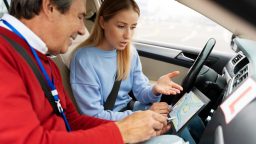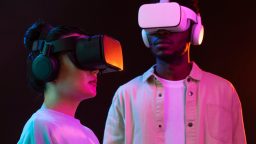In recent years, the landscape of education has evolved in extraordinary ways, with technology playing a pivotal role in shaping how we learn. One of the most exciting innovations in this area is Virtual Reality (VR), which has the potential to revolutionise the way we engage with educational content. By immersing students in fully interactive, 3D environments, VR offers a unique opportunity to enhance learning, increase engagement, and make complex subjects easier to understand. Let’s explore how VR is transforming education and the many benefits it brings to students, teachers, and educational institutions.
- Immersive Learning Experiences
One of the most significant advantages of VR in education is its ability to create immersive learning experiences. Traditional classrooms rely on textbooks, lectures, and videos to explain concepts, but VR allows students to experience subjects in a much more dynamic and interactive way. Whether it’s walking through ancient Rome, exploring the human circulatory system from the inside, or conducting scientific experiments in a virtual lab, VR brings abstract ideas to life in a way that is both engaging and memorable.
For example, history lessons can be transformed into virtual field trips where students visit historical sites and interact with their surroundings, providing a much deeper understanding of the past. Similarly, biology students can explore the inner workings of the human body in 3D, gaining a better grasp of complex structures and functions than they might through diagrams or textbooks alone.
- Personalised Learning Opportunities
Another major benefit of VR is its ability to offer personalised learning experiences. In a traditional classroom, it can be difficult to cater to the needs of every individual student, as different learners have different paces and styles of learning. VR, however, can be tailored to each student’s needs, allowing them to progress at their own pace and revisit lessons as often as necessary.
For example, students who may struggle with certain concepts can slow down the pace or review the material multiple times in a virtual environment without feeling left behind. On the other hand, students who grasp material quickly can advance to more challenging content without waiting for the rest of the class. This personalised approach not only enhances learning but also helps students feel more confident and motivated to continue their studies.
- Increased Engagement and Motivation
Engagement is one of the most critical factors when it comes to successful learning. Students are more likely to retain information and stay motivated when they are actively involved in their education. VR makes this possible by providing highly interactive and stimulating learning environments. Instead of passively watching a video or listening to a lecture, students are encouraged to participate in hands-on activities and problem-solving tasks within a virtual world.
This level of engagement can make learning much more exciting and enjoyable, leading to higher levels of motivation and improved educational outcomes. VR has been shown to significantly boost students’ attention spans and focus, as it allows them to explore and interact with content in ways that traditional methods simply cannot replicate.
- Collaboration and Social Learning
In addition to enhancing individual learning experiences, VR also promotes collaboration and social interaction among students. Many VR platforms allow students to interact with one another in real-time within a virtual environment, fostering teamwork and communication skills. Whether they are working together to solve a problem, exploring a virtual world, or participating in group activities, VR provides new ways for students to collaborate and share knowledge with their peers.
This social aspect of VR learning is particularly important in today’s increasingly interconnected world, where teamwork and communication are key skills in nearly every profession. By working together in a virtual environment, students can develop these skills while also learning from one another in ways that extend beyond traditional classroom settings.
- Accessibility and Inclusivity
VR also has the potential to make education more accessible to a wider range of students, including those with disabilities. For students with physical disabilities, VR can provide opportunities to experience activities and environments that might be difficult or impossible to access in real life. For example, a student who is unable to visit a museum due to mobility issues can take a virtual tour of the museum from the comfort of their home.
Additionally, VR can offer learning opportunities for students with special educational needs, allowing them to engage with content in a way that suits their learning style. For instance, students with autism can benefit from VR simulations that teach social skills in a safe, controlled environment. The flexibility and adaptability of VR technology make it a powerful tool for creating inclusive learning experiences for all students.
- Preparing for the Future Workforce
As technology continues to shape the future of work, it’s essential that students are equipped with the skills and knowledge they will need to thrive in an increasingly digital world. VR is helping to bridge the gap between education and the future workforce by providing students with the opportunity to gain hands-on experience in fields like engineering, healthcare, and architecture.
For example, medical students can use VR to practise complex surgeries in a risk-free environment, allowing them to hone their skills before working with real patients. Similarly, engineering students can experiment with virtual prototypes and designs, testing their ideas in a simulated environment before applying them to real-world projects. By offering these types of immersive, practical experiences, VR is helping to prepare students for the demands of tomorrow’s job market.
Conclusion
Virtual Reality is undeniably changing the way we approach education. From creating immersive learning experiences and offering personalised lessons to promoting collaboration and accessibility, VR is enhancing the educational experience in countless ways. As the technology continues to evolve, it’s likely that VR will become an even more integral part of the learning process, offering new opportunities for students, teachers, and educational institutions alike. The future of education is here, and it’s virtual.





